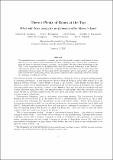There’s plenty of room at the Top: What will drive computer performance after Moore’s law?
Author(s)
Leiserson, Charles E; Thompson, Neil C; Emer, Joel S; Kuszmaul, Bradley C; Lampson, Butler W; Sanchez, Daniel; Schardl, Tao B; ... Show more Show less
DownloadAccepted version (343.9Kb)
Open Access Policy
Open Access Policy
Creative Commons Attribution-Noncommercial-Share Alike
Terms of use
Metadata
Show full item recordAbstract
The doubling of the number of transistors on a chip every 2 years, a seemly inevitable trend that has been called Moore's law, has contributed immensely to improvements in computer performance. However, silicon-based transistors cannot get much smaller than they are today, and other approaches should be explored to keep performance growing. Leiserson et al. review recent examples and argue that the most promising place to look is at the top of the computing stack, where improvements in software, algorithms, and hardware architecture can bring the much-needed boost.
Date issued
2020-06-05Department
Massachusetts Institute of Technology. Computer Science and Artificial Intelligence LaboratoryJournal
Science
Publisher
American Association for the Advancement of Science
Citation
Charles E. Leiserson et al. ,There’s plenty of room at the Top: What will drive computer performance after Moore’s law?. Science368,eaam9744 (2020).
Version: Author's final manuscript